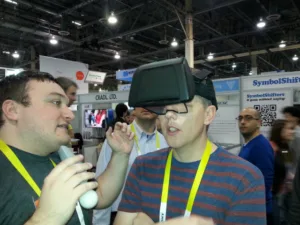Seebright, Inc. was in the Sands Expo at CES 2015 to introduce its new smartphone based head mounted display called the Wave and to show off its existing headset called the Pioneer. Both offer different optical designs than we have seen to date.
In the spring of 2014, Seebright started to show the Pioneer headset along with an SDK. As shown in the photo, this uses a smartphone placed in front of the forehead. A fold mirror relays this image to the fold-down optic that sits in front of the eyes. This optic can be transparent for augmented reality applications or reflective for virtual reality use. It is obviously quite big and clunky. The company said last March it would launch a Kickstarter campaign, but this must have failed or never been initiated as there is no record of the company on the site.
- Seebright Pioneer HMD
At CES 2015, the company showed the Pioneer along with a new design which it hopes to fund via Kickstarter. Called the Seebright Wave, the basic idea is to move the smartphone from in front of the eyes to a visor perpendicular to the eyes. A three-surface optical system can then be used to deliver 3D images to each eye. As shown in the graphic, the bottom surface reflects the image on the smartphone to the small reflective mirror nearest the smartphone. This relays the image to the optical surface in front of the eyes. Like the Pioneer, this last surface can be either semi-transparent for AR applications or fully reflective for VR use.
 Seebright HMD 2
Seebright HMD 2
This design allows for users to wear their eyeglasses and has an interocular adjustment. Seebright thinks it can deliver this design to consumers for under $150 even using an aspherical acrylic element in the design. The design is obviously very front heavy, so a counterweight is added to the back for better balance. Even so, the company says the headset will be less than 300 grams (without smartphone, we presume). Seebright plans to be able to accommodate the Nexus 6, Note 4 and iphone 6+. The company is considering adding a camera to the Wave design too as this configuration does not allow the use of the camera in the smartphone (it is pointing up).
 Seebright also showed a plastic headband and framework to support a smartphone horizontally in front of your forehead. It will be available with two sets of optics. One is transparent so that you can see the space around you at the same time that you view the content on the display. This is suitable for augmented reality applications (AR). The other set will not transmit light from your surroundings, which will create a more immersive experience for virtual reality (VR) applications.
Seebright also showed a plastic headband and framework to support a smartphone horizontally in front of your forehead. It will be available with two sets of optics. One is transparent so that you can see the space around you at the same time that you view the content on the display. This is suitable for augmented reality applications (AR). The other set will not transmit light from your surroundings, which will create a more immersive experience for virtual reality (VR) applications.
In either case, the display on the smartphone can be split into two regions, each half sending a different image to each eye of the wearer. This allows the application to create stereoscopic 3D images.
The beauty of this approach is that you get all the computing power, connectivity, and sensors contained in the smartphone in the bargain. This means that applications can access the Internet for data on the fly, and can exchange data with other devices through Bluetooth and WiFi wireless connections. The GPS and motion sensors in the phone can be used for location and head-tracking functions, which are important in VR and AR applications.
The company has created a Bluetooth-enabled controller that can be used in three-dimensional space to interact with applications. They plan to launch a Kickstarter campaign soon to help fund the development of the final product.
 The company has gone further than most in terms of interaction with the AR or VR image. There are three ways to interact:
The company has gone further than most in terms of interaction with the AR or VR image. There are three ways to interact:
- Use the gyros integrated in the headset to turn your head and see new images
- Use buttons on the wireless controller to move the image
- Use the gyros on the wireless controller to change the image
The wireless controller has 9 axes on motion tracking built in and can include visual tracking of the controller if external cameras are used.
The Seebright SDK is based upon WebGL and Unity3D to enable an easy, smartphone agnostic, cross-platform development environment. To encourage diversity in initial application development, Seebright will operate a cloud portal for developers to share code, assets and applications.
So far, the company has raised $2M in seed capital. A Kickstarter campaign is planned for February and a Series A VC round for April.

